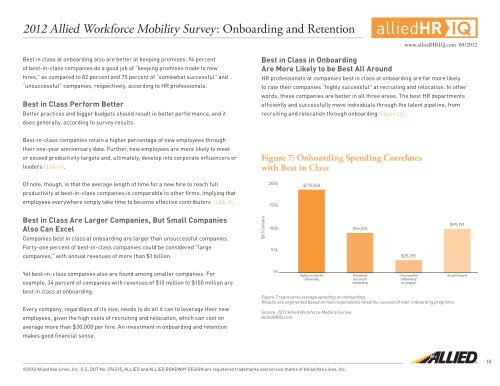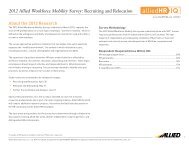2012 Allied Workforce Mobility Survey: Onboarding and Retention
2012 Allied Workforce Mobility Survey: Onboarding and Retention
2012 Allied Workforce Mobility Survey: Onboarding and Retention
You also want an ePaper? Increase the reach of your titles
YUMPU automatically turns print PDFs into web optimized ePapers that Google loves.
<strong>2012</strong> <strong>Allied</strong> <strong>Workforce</strong> <strong>Mobility</strong> <strong>Survey</strong>: <strong>Onboarding</strong> <strong>and</strong> <strong>Retention</strong><br />
Best in class at onboarding also are better at keeping promises: 94 percent<br />
of best-in-class companies do a good job of “keeping promises made to new<br />
hires,” as compared to 82 percent <strong>and</strong> 75 percent of “somewhat successful” <strong>and</strong><br />
“unsuccessful” companies, respectively, according to HR professionals.<br />
Best in Class Perform Better<br />
Better practices <strong>and</strong> bigger budgets should result in better performance, <strong>and</strong> it<br />
does generally, according to survey results.<br />
Best-in-class companies retain a higher percentage of new employees through<br />
their one-year anniversary date. Further, new employees are more likely to meet<br />
or exceed productivity targets <strong>and</strong>, ultimately, develop into corporate influencers or<br />
leaders (Table 4).<br />
Of note, though, is that the average length of time for a new hire to reach full<br />
productivity at best-in-class companies is comparable to other firms, implying that<br />
employees everywhere simply take time to become effective contributors (Table 4).<br />
Best in Class Are Larger Companies, But Small Companies<br />
Also Can Excel<br />
Companies best in class at onboarding are larger than unsuccessful companies.<br />
Forty-one percent of best-in-class companies could be considered “large<br />
companies,” with annual revenues of more than $1 billion.<br />
Yet best-in-class companies also are found among smaller companies. For<br />
example, 34 percent of companies with revenues of $10 million to $100 million are<br />
best in class at onboarding.<br />
Every company, regardless of its size, needs to do all it can to leverage their new<br />
employees, given the high costs of recruiting <strong>and</strong> relocation, which can cost on<br />
average more than $30,000 per hire. An investment in onboarding <strong>and</strong> retention<br />
makes good financial sense.<br />
Best in Class in <strong>Onboarding</strong><br />
Are More Likely to be Best All Around<br />
©<strong>2012</strong> <strong>Allied</strong> Van Lines, Inc. U.S. DOT No. 076235, ALLIED <strong>and</strong> ALLIED ROADWAY DESIGN are registered trademarks <strong>and</strong> service marks of <strong>Allied</strong> Van Lines, Inc.<br />
IQ<br />
www.alliedHRIQ.com 05/<strong>2012</strong><br />
HR professionals at companies best in class at onboarding are far more likely<br />
to rate their companies “highly successful” at recruiting <strong>and</strong> relocation. In other<br />
words, these companies are better in all three areas. The best HR departments<br />
efficiently <strong>and</strong> successfully move individuals through the talent pipeline, from<br />
recruiting <strong>and</strong> relocation through onboarding (Figure 12).<br />
Figure 7 represents average spending on onboarding.<br />
Results are segmented based on how respondents rated the success of their onboarding programs.<br />
Source: <strong>2012</strong> <strong>Allied</strong> <strong>Workforce</strong> <strong>Mobility</strong> <strong>Survey</strong><br />
<strong>Allied</strong>HRIQ.com<br />
10



